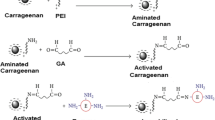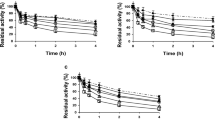Abstract
Grey mullet (Mugil cephalus) lipase was isolated using para-aminobenzamidine agarose and immobilized on octyl Sepharose CL-4B (o-Sep). Immobilized grey mullet lipase (GMLi) had a 10 °C higher optimum temperature compared to the free enzyme and showed remarkable thermal stability. GMLi was most active within the pH range of 8.0–9.5 with an optimum at 8.5. Immobilization also enhanced the storage stability and reusability of the enzyme with minimal changes in efficiency during repeated batches. GMLi showed variable stabilities in various organic solvents. A signal in the amide I absorption region of the FTIR spectrum of GMLi was attributed to the protein layer on o-Sep. The surface morphology of o-Sep was visualized on a Zeiss stereomicroscope as globular-shaped beads.







Similar content being viewed by others
References
Delorme, V., Dhouib, R., Canaan, S., Fotiadu, F., Carrière, F., & Cavalier, J.-F. (2011). Effects of surfactants on lipase structure, activity, and inhibition. Pharmaceutical Research, 28, 1831–1842.
Zaks, A., & Klibanov, A. M. (1985). Enzyme-catalyzed processes in organic solvents. Proceedings of the National Academy of Sciences, 82, 3192–3196.
Pogorevc, M., Stecher, H., & Faber, K. (2002). A caveat for the use of log P values for the assessment of the biocompatibility of organic solvents. Biotechnology Letters, 24, 857–860.
Bastida, A., Sabuquillo, P., Armisen, P., Fernández-Lafuente, R., Huguet, J., & Guisán, J. M. (1998). A single step purification, immobilization, and hyperactivation of lipases via interfacial adsorption on strongly hydrophobic supports. Biotechnology and Bioengineering, 58(5), 486–493.
Palomo, J. M., Ortiz, C., Fuentes, M., Fernandez-Lorente, G., Guisan, J. M., & Fernandez-Lafuente, R. (2004). A single step purification, immobilization, and hyperactivation of lipases via interfacial adsorption on strongly hydrophobic supports. Journal of Chromatography A, 1038, 267–273.
Mateo, C., Palomo, J. M., Fernandez-Lorente, G., Guisan, J. M., & Fernandez-Lafuente, R. (2007). Improvement of enzyme activity, stability and selectivity via immobilization techniques. Enzyme and Microbial Technology, 40(6), 1451–1463.
Tufvesson, P., Törnvall, U., Carvalho, J., Karlsson, A. J., & Hatti-Kaul, R. (2011). Towards a cost-effective immobilized lipase for the synthesis of specialty chemicals. Journal of Molecular Catalysis B: Enzymatic, 68(2), 200–205.
Tischer, W., & Wedekind, F. (1999). Immobilized Enzymes: Methods and Applications. Topics in Current Chemistry, 200, 96–126.
Garcia-Galan, C., Berenguer-Murcia, A., Fernandez-Lafuente, R., & Rodrigues, R. C. (2011). Potential of different enzyme immobilization strategies to improve enzyme performance. Advanced Synthesis and Catalysis, 353(16), 2885–2904.
Iso, M., Chen, B., Eguchi, M., Kudo, T., & Shrestha, S. (2001). Production of biodiesel fuel from triglycerides and alcohol using immobilized lipase. Journal of Molecular Catalysis B: Enzymatic, 16, 53–58.
Fjerbaek, L., Christensen, K. V., & Norddahl, B. (2009). A review of the current state of biodiesel production using enzymatic transesterification. Biotechnology and Bioengineering, 102(5), 1298–1315.
Pencreac’h, G., & Baratti, J. C. (2001). Comparison of hydrolytic activity in water and heptane for thirty-two commercial lipase preparations. Enzyme and Microbial Technology, 28(4–5), 473–479.
Kurtovic, I., Marshall, S. N., & Zhao, X. (2011). Hydrophobic immobilization of a bile salt activated lipase from Chinook salmon (Oncorhynchus tshawytscha). Journal of Molecular Catalysis B: Enzymatic, 72(3–4), 168–174.
Aryee, A. N. A., Simpson, B. K., & Villalonga, R. (2007). Lipase fraction from the viscera of grey mullet (Mugil cephalus): Isolation, partial purification and some biochemical characteristics. Enzyme and Microbial Technology, 40(3), 394–402.
Yang, F., Su, W.-J., B-J, L., Wu, T., Sun, L.-C., Hara, K., et al. (2009). Purification and characterization of chymotrypsins from the hepatopancreas of crucian carp (Carassius auratus). Food Chemistry, 116(4), 860–866.
Sila, A., Nasri, R., Jridi, M., Balti, R., Nasri, M., & Bougatef, A. (2012). Characterisation of trypsin purified from the viscera of Tunisian barbel (Barbus callensis) and its application for recovery of carotenoproteins from shrimp wastes. Food Chemistry, 132(3), 1287–1295.
Bradford, M. M. (1976). Rapid and sensitive method for the quantitation of microgram quantities of protein utilizing the principle of protein-dye binding. Analytical Biochemistry, 72, 248–254.
Kordel, M., Hofmann, B., Schomburg, D., & Schmid, R. (1991). Extracellular lipase of Pseudomonas sp. Strain ATCC 21808: purification, characterization, crystallization and preliminary X-ray diffraction data. Journal of Bacteriology, 173, 4836–4841.
Pencreac’h, G., Leullier, M., & Baratti, J. C. (1997). Properties of free and immobilised lipase from Burkholderia cepacia. Biotechnology and Bioengineering, 56, 181–189.
Erlanger, B. F., Kokowsky, N., & Colen, W. (1961). The preparation and properties of two new chromogenic substrates of trypsin. Archives of Biochemistry and Biophysics, 95, 271–278.
Soumanou, M. M., & Bornscheuer, U. T. (2003). Lipase-catalyzed alcoholysis of vegetable oils. European Journal of Lipid Science and Technology, 105(11), 656–660.
De-Simone, S. G., Correa-Netto, C., Antunes, O. A. C., De-Alencastro, R. B., & Silva, F. P., Jr. (2005). Biochemical and molecular modeling analysis of the ability of two p-aminobenzamidine-based sorbents to selectively purify serine proteases (fibrinogenases) from snake venoms. Journal of Chromatography B, 822(1–2), 1–9.
Sörensen, M. H., Ng, J. B. S., Bergström, L., & Alberius, P. C. A. (2010). Improved enzymatic activity of Thermomyces lanuginosus lipase immobilized in a hydrophobic particulate mesoporous carrier. Journal of Colloid and Interface Science, 343(1), 359–365.
Weetall, H. H. (1976). Covalent coupling methods for inorganic support materials. Methods in Enzymology, 44, 134–148.
Derewenda, U., Brozowski, A. M., Lawson, D. M., & Derewenda, Z. S. (1992). Catalysis at the interface: the anatomy of a conformational change in a triglyceride lipase. Biochemistry, 31, 1532–1541.
Tiss, A., Frédéric Carrière, F., & Verger, R. (2001). Effects of gum Arabic on lipase interfacial binding and activity. Analytical Biochemistry, 294(1), 36–43.
Fernandez-Lorente, G., Palomo, J. M., Cabrera, Z., Fernandez-Lafuente, R., & Guisáán, J. M. (2007). Improved catalytic properties of immobilized lipases by the presence of very low concentrations of detergents in the reaction medium. Biotechnology and Bioengineering, 97(2), 242–250.
Blout, E. R., De Loze, C., & Asadourian, A. (1961). The deuterium exchange of water-soluble polypeptides and proteins as measured by infrared spectroscopy. Journal of the American Chemical Society, 83(8), 1895–1900.
Pelton, J. T., & McLean, L. R. (2000). Spectroscopic methods for analysis of protein secondary structure. Analytical Biochemistry, 277(2), 167–176.
Hong, J., Xu, D., Gong, P., Yu, J., Ma, H., & Yao, S. (2008). Covalent-bonded immobilization of enzyme on hydrophilic polymer covering magnetic nanogels. Microporous and Mesoporous Materials, 109(1–3), 470–477.
Gagnon, M. D., & Vasudevan, P. T. (2011). Effects of solvent and enzyme source on transesterification activity. Energy & Fuels, 25(10), 4669–4674.
Aryee, A. N. A., Simpson, B. K., Cue, R. I., & Phillip, L. E. (2011). Enzymatic transesterification of fats and oils from animal discards to fatty acid ethyl esters for potential fuel use. Biomass and Bioenergy, 35(10), 4149–4157.
Lima, V. M. G., Krieger, N., Mitchell, D. A., & Fontana, J. D. (2004). Activity and stability of a crude lipase from Penicillium aurantiogriseum in aqueous media and organic solvents. Biochemical Engineering Journal, 18, 65–71.
Laane, C., Sjef, B., Kees, V., & Cees, V. (1987). Rules for optimization of biocatalysis in organic solvents. Biotechnology and Bioengineering, 30(1), 81–87.
Ryczkowski, J. (2007). Spectroscopic evidences of EDTA interaction with inorganic supports during the preparation of supported metal catalysts. Vibrational Spectroscopy, 43(1), 203–209.
Acknowledgments
The authors acknowledge the financial support provided by the Natural Sciences and Engineering Research Council (NSERC Discovery Grant Program) of Canada, Diana Valtierra Rodriguez for help with FTIR data acquisition, and Dr. Ashraf A. Ismail for guidance, spectral analyses, and invaluable discussions.
Author information
Authors and Affiliations
Corresponding author
Rights and permissions
About this article
Cite this article
Aryee, A.N.A., Simpson, B.K. Immobilization of Lipase from Grey Mullet. Appl Biochem Biotechnol 168, 2105–2122 (2012). https://doi.org/10.1007/s12010-012-9921-3
Received:
Accepted:
Published:
Issue Date:
DOI: https://doi.org/10.1007/s12010-012-9921-3




